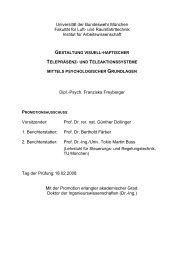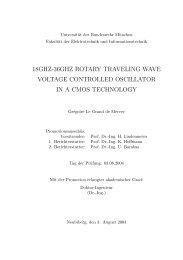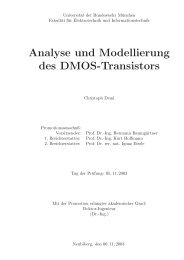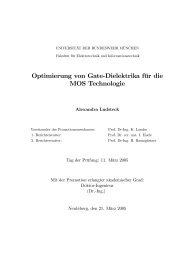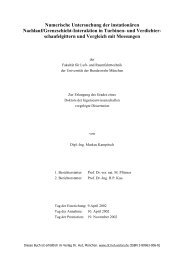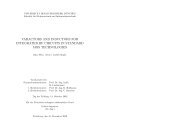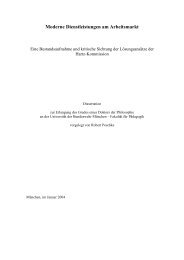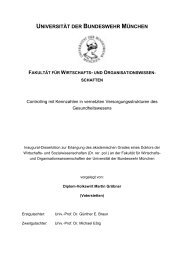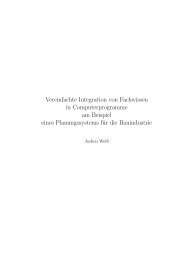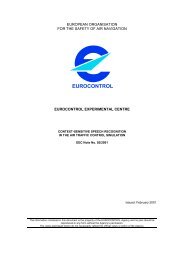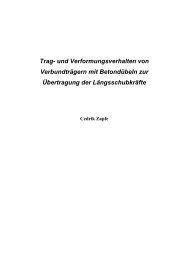Precise Orbit Determination of Global Navigation Satellite System of ...
Precise Orbit Determination of Global Navigation Satellite System of ...
Precise Orbit Determination of Global Navigation Satellite System of ...
Create successful ePaper yourself
Turn your PDF publications into a flip-book with our unique Google optimized e-Paper software.
Chapter 7 <strong>Orbit</strong> <strong>Determination</strong> Using Carrier Phase Observation<br />
λλ<br />
∃ 1 3<br />
ρ ( III)<br />
= ( Φ1 −Φ 3 − N13)<br />
(7-34)<br />
λ − λ<br />
3 1<br />
∃ ρ<br />
∃<br />
( III) N1 = Φ1 −<br />
λ 1<br />
∃ ρ<br />
∃<br />
( III) N2 = Φ2 −<br />
λ 2<br />
∃ ρ<br />
∃<br />
( III)<br />
N3<br />
= Φ3<br />
−<br />
λ 3<br />
(7-35)<br />
N : [ N N N N N<br />
∃ = ] : = [ ] : = [ ]<br />
(7-36)<br />
1 1 2 2 3 3<br />
The first step is very important for the successful solution <strong>of</strong> the initial integer ambiguities for TCAR algorithm.<br />
If under strong multipath environment, the error <strong>of</strong> ∃ ρ ( I ) is larger than ±10 meter, it is impossible for N12 to get<br />
integer solution. Thus from the second step to the last step, a big bias will be introduced into all integer<br />
ambiguity solutions, which lead to ambiguity resolution failure.<br />
The multipath effects may be reduced using linear combinations, which will be discussed in the next section.<br />
L3 is an ionospheric-free linear combination that is little affected by multipath effects as well (see Table 7-7). In<br />
order to eliminate the influence <strong>of</strong> multipath effects and ionospheric errors on TCAR algorithm, the ionosphere-<br />
free or multipath-free linear combination <strong>of</strong> E1/E3 code measurements should be formed as the first step for<br />
ρ ( I ) , i.e. improved TCAR steps may be written as follows,<br />
Step1:<br />
Ionospheric-free linear combinations <strong>of</strong> E1 and E3 code pseudoranges should be produced by<br />
2<br />
2<br />
f<br />
∃ E1<br />
fE3<br />
ρ( I)<br />
= ρE−ρ 2 2 1 2<br />
E<br />
f − f f − f<br />
E1E3 2 3 (7-37)<br />
E1E3 From Table 7-7, it is guaranteed that ∃ ρ ( I ) has much little influence from ionospheric errors and multipath<br />
effects. Thus the float ambiguity ∃ N 12 is solved by using widelane linear combinations <strong>of</strong> E1 and E2 phase<br />
observations and ∃ ρ ( I)<br />
∃ 1 1<br />
12: = Φ1−Φ2−( − )∃ ρ ( )<br />
(7-38)<br />
λ λ<br />
N I<br />
1 2<br />
Because the wave length <strong>of</strong> linear combination <strong>of</strong> Φ1 − Φ2<br />
is about 10 meter and the accuracy <strong>of</strong> ∃ ρ ( I ) is much<br />
better than 10 meter, integer ambiguity N12 can easily be obtained by rounding ∃ N12 to the nearest integer, i.e.<br />
N : [ N∃<br />
= ]<br />
(7-39)<br />
12 12<br />
where<br />
N12 integer ambiguity<br />
∃N 12 float ambiguity<br />
N∃ : = N − N<br />
12 1 2<br />
Step 1 is a big difference from the original TCAR algorithm Eq.(7-28) and will significantly reduce the<br />
ionospheric errors and multipath effects. In Step 2 there is no influence from multipath effects, hence Step 2 does<br />
not need to be changed. Step 3 also remains without changes.<br />
From the discussion above it is clear that TCAR still can not guarantee 100% success in the integer ambiguity<br />
resolution <strong>of</strong> original carrier phase observations. The key step is the last step. For example, if L1 is strongly<br />
affected by ionospheric and/or multipath errors, the last step will not be successful. In other words, the accuracy<br />
<strong>of</strong> ∃ ρ ( III ) in Eq.(7-34) and Eq.(7-35) should be better than 0.10 meter, otherwise, the last step may be a failure.<br />
94



